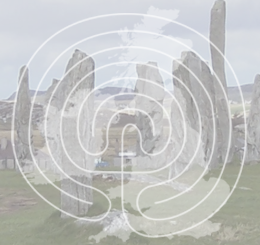Castell Tomen-y-Mur, (a.k.a. Mur-y-Castell and Heriri Mons)
Tomen-y-Mur (translated as ‘Mound in the Walls’) was originally an ancient Roman fort on the slope of Mynydd Maentwrog to the north east of Llyn Trawsfynyedd, with access from A470 although it is not signposted. It stood in a prominent position on the road from Brithdir (near Dolgellau) to Segontium (Caernarfon) via Pen Llystyn at Bryncir. The history of this exposed site is long, complicated and difficult to interpret since it spans from the first, through to the twelfth century.
 The Romans called the fort Heriri Mons. They probably started building a wooden fortified structure at the site in around AD 78, under the orders of Governor Gnaeus Julius Agricola. The structure was then reduced in size slightly in around AD 110 under Hadrian, when it was rebuilt in stone. The Romans eventually abandoned the fort in about AD 140 and never reoccupied it. So why was the fort built? The native Celtic tribe in Northwest Wales were the Ordovices (as the Romans named them) and they were rather reluctant to become citizens of the Roman Empire. Under the leadership of Caratacus they fought a guerrilla war against the Romans during the AD 50’s. After the Battle of Caer Caradoc, the Ordovices, heavily defeated ceased to be a threat to the Empire. Then shortly before Agricola’s governorship, in AD 77 they managed to massacre an entire regiment of Roman cavalry as an act of war. Agricola’s response was merciless and he effectively wiped the Ordovician nuisance out. Therefore the fort was built to maintain order and protect the road communications in the area they now controlled. The initial timber fort could have probably housed a thousand Roman cavalry, but the later stone fort would only have housed about five hundred infantry. This suggests that the area was later stabilised and the legionaries were performing a garrison role towards the end, before its abandonment.
The Romans called the fort Heriri Mons. They probably started building a wooden fortified structure at the site in around AD 78, under the orders of Governor Gnaeus Julius Agricola. The structure was then reduced in size slightly in around AD 110 under Hadrian, when it was rebuilt in stone. The Romans eventually abandoned the fort in about AD 140 and never reoccupied it. So why was the fort built? The native Celtic tribe in Northwest Wales were the Ordovices (as the Romans named them) and they were rather reluctant to become citizens of the Roman Empire. Under the leadership of Caratacus they fought a guerrilla war against the Romans during the AD 50’s. After the Battle of Caer Caradoc, the Ordovices, heavily defeated ceased to be a threat to the Empire. Then shortly before Agricola’s governorship, in AD 77 they managed to massacre an entire regiment of Roman cavalry as an act of war. Agricola’s response was merciless and he effectively wiped the Ordovician nuisance out. Therefore the fort was built to maintain order and protect the road communications in the area they now controlled. The initial timber fort could have probably housed a thousand Roman cavalry, but the later stone fort would only have housed about five hundred infantry. This suggests that the area was later stabilised and the legionaries were performing a garrison role towards the end, before its abandonment.
The Roman remains at the site are extensive, and include earthworks beyond the fort, parade grounds, a temple, an amphitheatre (probably to compensate for the bleak posting), burial mounds, a bath house, and a mansio (a stopping or resting place on the road, like an inn). The site covers an area of 4.5 acres, or 1.7 hectares.
After the Romans left the area, the fort probably continued to be important into the medieval period, because a fifth century gravestone has been uncovered there. The Cunedda family line of Welsh princes may have moved into the fort after the Romans, for it is mentioned in Welsh folklore, particularly the Mabinogion. Tomen-y-Mur was taken over by the Normans in the late eleventh or early twelfth Century, when the defences would have been refortified. The ‘Tomen’ which is the now dominant Norman castle motte, was probably built at this time, when William Rufus was sent to counter the Welsh insurgency in 1095, although he didn’t stay long, and was glad to return home and get away from Gruffydd ap Cynan and his forces.
Interestingly, Haverfield records nine inscribed stones found in the structure of Harlech Castle bearing Latin inscriptions. Each stone depicts in ‘paces’ various lengths of completed fortress wall, and the ‘centuria’ or unit of 100 men that built it. It is therefore speculated that most of the shaped stone from the fortress of Tomen-y-Mur was used to construct the mighty castle at Harlech from 1283.
The Snowdonia National Park Authority has reconstructed part of the fortress wall to as it would have looked during the Roman occupation.
In Welsh Mythology, Mur-y-Castell was the Palace of Ardudwy, mentioned in the fourth branch of the Mabinogi, ‘Math son of Mathonwy’. It was at Mur-y-Castell that Lleu Llaw Gyffes (supposed son or nephew of Gwydion) lived with his beautiful wife Blodeuedd, see Llyn Morwynion ‘Lake of the Maidens’.



Recent Comments